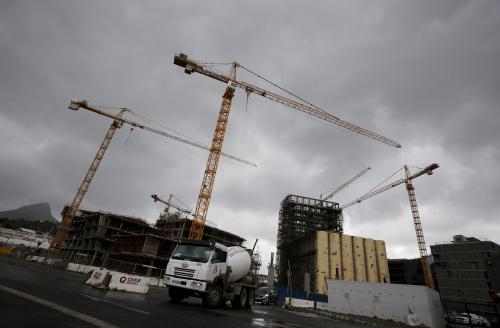This year, Africa’s Industrialization Day focused on raising awareness of the importance of African industrial development in implementing a successful Continental Free Trade Area (CFTA), fostering economic growth, and alleviating poverty. A continent-wide endeavor, the CFTA aims to create a single market for goods and services in Africa. On November 20, I spoke at a high-level conference organized in New York by the United Nations Industrial Development Organization (UNIDO), the Office of the Special Adviser on Africa, and the Permanent Observer Mission of the African Union to the United Nations to discuss how the CFTA and Africa’s industrialization go hand-in-hand for successful African growth. I outline the three main themes of our conversation below.
The potential impact of the CFTA includes boosting intra-Africa trade, manufacturing exports, job creation for youth, and poverty alleviation.
The potential for the CFTA is big for both structural transformation and poverty alleviation in Africa. Some studies show that by creating a pan-African market, the CFTA could increase intra-Africa trade by about 52 percent, resulting in an increase of African manufacturing exports. Right now, on average, manufacturing only represents about 10 percent of total GDP in Africa, lagging behind other developing regions. A successful CFTA could reduce this gap by increasing the growth of the manufacturing sector and its value added given the CFTA’s market size of 1.2 billion people and over $3.4 trillion of cumulative GDP.
Since one of the critical causes of the high poverty rate in Africa is the scarcity of sustainable and well-paid jobs, the growth of the manufacturing sector—which will most likely lead to job creation, especially for the youth—will contribute to poverty alleviation. In sub-Saharan Africa alone, over 70 percent of the region’s population is below age 30. A youth in Africa now is twice as likely to be unemployed when he or she becomes an adult. In addition, 70 percent of Africa’s youth live on less than $2 per day. Considering that industry represents one-quarter to one-third of total job creation in other regions of the world, industrial development in Africa will most likely create new opportunities, more jobs, and contribute to poverty alleviation. In conclusion, the CFTA will bring about structural transformation in Africa, unlocking growth potential, transforming the structure of the economy, and contributing to poverty alleviation.
The industrial policies needed to increase the CFTA’s impact must focus on productivity, competition, diversification, and economic complexity.
A holistic approach to industrial policy, focusing on diversification and economic complexity, is critical for increasing the CFTA’s impact. In fact, data shows that the most economically diverse countries are also the most successful, and such dynamism will increase the CFTA’s impact both on the continent and globally.
Bearing this in mind, policymakers must emphasize five key drivers of successful manufacturing when elaborating industrial policies. These include:
- Human capital: In order to grow and be competitive, the manufacturing sector needs capable, healthy, and skilled workers. Policymakers should adjust curriculum to ensure that skills are adapted to the market and should include special attention to youth. Policymakers should revisit education curricula to focus on skills acquisition and build capacity for entrepreneurship and self-employment through business training at an early age, skills upgrading at an advanced one, and better promotion of science, technology, engineering, entrepreneurship, and mathematics as well as vocational and on-the-job trainings. In other words, they should build the human capital necessary for the industrialization of the continent. Policymakers should also favor the continental migration of highly skilled workers as an immediate solution for pressing human capital needs.
- Cost: In order to accelerate industrial development, policymakers must bring the cost of doing business down, addressing cost-effectiveness challenges such as energy, access to roads and ports, security, financing, bureaucratic restrictions, corruption, dispute settlement, and property rights, among others. They should also ensure the effectiveness of special economic zones to fast-track the process.
- Supply network: Industries are more likely to evolve in the presence of sufficient or competitive networks. Policymakers should increase the size of the supply market by easing trade restrictions, integrating regional trade networks, increasing the country ability to develop sophisticated products, and lifting the barriers to small and medium-size business growth and development. Successful industrial policies, in this way, are key to the CFTA, as one of the CFTA’s goals is to “expand inter-Africa trade through better harmonization and coordination of trade liberalization and facilitation regimes and instruments across RECs and across Africa in general.”
- Domestic demands: Policymakers should offer tax incentives to firms in order to unlock job creation and increase individual and household incomes. Higher purchasing power for households will increase the size of the domestic market given the rapid growth of the demand of manufactured products. This increase in domestic demand will also contribute to the creation of pan-African demand, which, associated with the removal of trade barriers, protectionist policies, and subsidies, will help fulfill CFTA’s goal of “single continental market for goods and services, with free movement of business persons and investments.”
- Resources: Manufactures require heavy investment and should be driven by the private sector. Policymakers should facilitate access to finance, especially for small and medium enterprises, by developing and effectively managing instruments appropriate to the stage of development (loans, guaranties, and ventures funds) in critical sectors. In order better attract foreign direct investment, policymakers should address the poor risk perception that scares off potential investors or sets excessive returns expectations. Policymakers should also mobilize domestic resources, curve illicit flows, appropriately manage state revenues, and invest to stimulate inclusive economic growth.
However, these five areas are not the only ones required for successful industrial policies. Decisionmakers should also facilitate research and development, enable technological innovation, curve the productivity gaps, increase competitiveness with deregulation, facilitate the coordination among actors, upgrade their commodity sectors to add value and boost productivity and competitiveness, and promote the development of higher-productivity sectors. In sum, a holistic and multisectoral approach is critical to enable and increase the CFTA’s impact.
The role of CFTA’s implementation in facilitating industrialization is that it creates a continental market, unlocks manufacturing potential, and bolsters an international negotiation block.
If appropriate industrial policies can substantially increase the CFTA’s impact, as discussed above, a successful implementation of the CFTA could also significantly foster Africa’s industrialization. In fact, one of the CFTA’s goals is to “enhance competitiveness at the industry and enterprise level through exploiting opportunities for scale production, continental market access, and better reallocation of resources.” This goal could be accomplished through four mechanisms: The CFTA is likely to generate a greater diversification of African economies, given the access to a larger market, which in turn will foster industrialization. A successfully implemented CFTA will also contribute to increased productivity as firms will better allocate resources and exploit opportunities for scale production and continental market access, which in turn may result in important industrialization outcomes. Another contribution to industrialization would be through technology transfer: Higher competition among countries and firms will favor technical progress and stimulate investment, as “exports generate efficiency and learning effects.” Finally, the CFTA will also provide African leaders with a greater negotiating power to eliminate barriers to exporting (facilitate negotiation with the European Union, the United States, etc.). This will help prevent asymmetric agreements likely to hurt exports and industrial development on the continent. Along the way, the specificities of small countries, islands, landlocked countries, and less industrialized economies should be taken into consideration as to not leave any country behind in sustainable industrialization.
The Brookings Institution is committed to quality, independence, and impact.
We are supported by a diverse array of funders. In line with our values and policies, each Brookings publication represents the sole views of its author(s).








Commentary
3 things to know about Africa’s industrialization and the Continental Free Trade Area
November 22, 2017